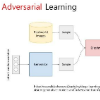Existing face forgery detection methods usually treat face forgery detection as a binary classification problem and adopt deep convolution neural networks to learn discriminative features. The ideal discriminative features should be only related to the real/fake labels of facial images. However, we observe that the features learned by vanilla classification networks are correlated to unnecessary properties, such as forgery methods and facial identities. Such phenomenon would limit forgery detection performance especially for the generalization ability. Motivated by this, we propose a novel method which utilizes adversarial learning to eliminate the negative effect of different forgery methods and facial identities, which helps classification network to learn intrinsic common discriminative features for face forgery detection. To leverage data lacking ground truth label of facial identities, we design a special identity discriminator based on similarity information derived from off-the-shelf face recognition model. With the help of adversarial learning, our face forgery detection model learns to extract common discriminative features through eliminating the effect of forgery methods and facial identities. Extensive experiments demonstrate the effectiveness of the proposed method under both intra-dataset and cross-dataset evaluation settings.
翻译:现有伪造证件检测方法通常将面部伪造证件检测作为二进制分类问题处理,并采用深刻的神经网络来学习歧视特征。理想的区别特征应当仅与面部图像的真实/假标签有关。然而,我们注意到香草分类网络所学特征与不必要的属性相关,例如伪造方法和面部特征。这种现象将限制伪造证件检测的性能,特别是一般化能力。我们为此提出一种新的方法,利用对抗性学习来消除不同伪造方法和面部特征的负面影响,帮助分类网络学习面部伪造识别的内在共同歧视特征。为了利用缺乏面部身份地面真实标签的数据,我们根据从现成的面部识别模型中获得的相似性信息设计了一种特殊的身份识别特征。在对抗性学习的帮助下,我们的面部伪造检测模型学会通过消除伪造方法和面部特征的影响来找出常见的歧视性特征。广泛的实验表明内部数据和交叉数据评估环境中拟议方法的有效性。



